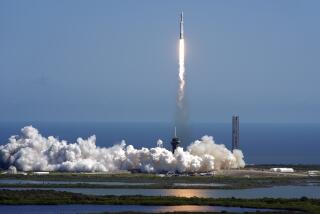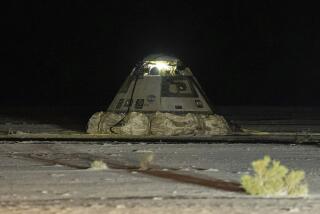NASA ends Phoenix mission on Mars
After hearing nothing from the Phoenix spacecraft in more than a week, NASA officials on Monday declared an end to the nearly six-month mission at Mars’ north pole, the first to touch and taste the water on an alien planet.
Phoenix sent its last message on Nov. 2 before a lack of power caused it to go to sleep -- permanently, it now appears.
The craft survived nearly three months longer than its expected 90-day mission but was finally done in by a combination of plunging temperatures with the approach of the Martian winter and the effects of an arctic dust storm that coated the lander’s solar panels.
“We are ceasing operations and declaring an end to the mission,” Phoenix project manager Barry Goldstein said Monday.
Other spacecraft orbiting Mars will continue to listen for messages for the next few weeks, he said, but he held out little hope that Phoenix would be heard from again.
Pronouncing the $475-million mission a success, Doug McCuistion, director of NASA’s Mars Exploration Program, said the end should be an occasion for celebration rather than disappointment.
“This is an Irish wake rather than a funeral,” he said during a briefing with reporters at NASA headquarters in Washington.
After landing May 25 on a dimpled Martian plain, Phoenix made several discoveries that revolutionized scientific understanding of the Red Planet.
Besides becoming the first spacecraft to dig into the ice on another planet, Phoenix discovered that the Martian soils, at least in the northern plains, were much more conducive to life than expected. Rather than finding hostile acidic soils, Phoenix found the soils are alkaline and could be hospitable to a variety of plant life.
The lander’s suite of science instruments, which included a wet chemistry lab and eight tiny ovens to bake and sniff the soils, also detected salts in the form of perchlorate. That’s a pollutant in municipal water systems on Earth but a potential nutrient for simple organisms.
Near the end of the mission, the lander’s weather station surprised mission managers by detecting snow in the atmosphere.
Peter Smith, University of Arizona planetary scientist and chief scientist for the mission, said the data gathered by Phoenix would keep analysts busy for months, if not years.
“This has been a grand adventure,” McCuistion said.
But there were also problems with the mission -- chief among them Phoenix’s inability to get a substantial sample of ice into the Thermal and Evolved Gas Analyzer, known as TEGA.
The Martian ice and soils proved stickier and clumpier than on Earth, making it more difficult to scoop the material into TEGA’s tiny ovens, which were designed to cook samples to determine if they contained any organic compounds, the building blocks of life.
That failure may have compromised the mission’s ability to determine whether the northern plains of Mars ever were, or still might be, habitable for some simple life forms.
Scientists have not turned up any evidence of carbon-containing organic compounds, but Smith said the evidence could still be hiding in mounds of data yet to be analyzed.
Mission managers were racing against time to get more science out of the lander as the Martian day began to shorten with the approach of winter, when temperatures can drop to minus 292 degrees Fahrenheit.
The final blow was a dust storm in late October that coated the solar panels, further compromising Phoenix’s ability to generate power.
Lessons learned by Phoenix will influence the operation of the Mars Science Lab, a lander the size of an SUV that will be able, like the Mars rovers Spirit and Opportunity, to drive from place to place, performing analyses. MSL is scheduled to launch in 2009.
--






